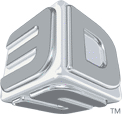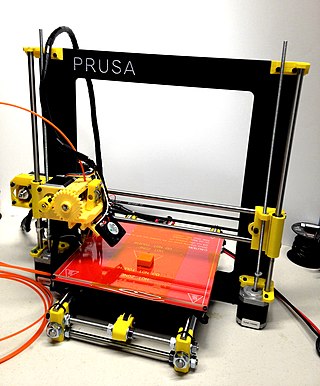
Stereolithography is a form of 3D printing technology used for creating models, prototypes, patterns, and production parts in a layer by layer fashion using photochemical processes by which light causes chemical monomers and oligomers to cross-link together to form polymers. Those polymers then make up the body of a three-dimensional solid. Research in the area had been conducted during the 1970s, but the term was coined by Chuck Hull in 1984 when he applied for a patent on the process, which was granted in 1986. Stereolithography can be used to create prototypes for products in development, medical models, and computer hardware, as well as in many other applications. While stereolithography is fast and can produce almost any design, it can be expensive.

3D printing or additive manufacturing is the construction of a three-dimensional object from a CAD model or a digital 3D model. It can be done in a variety of processes in which material is deposited, joined or solidified under computer control, with the material being added together, typically layer by layer.

Stratasys, Ltd. is an American-Israeli manufacturer of 3D printers, software, and materials for polymer additive manufacturing as well as 3D-printed parts on-demand. The company is incorporated in Israel. Engineers use Stratasys systems to model complex geometries in a wide range of polymer materials, including: ABS, polyphenylsulfone (PPSF), polycarbonate (PC) and polyetherimide and Nylon 12.

Z Corporation it a company that makes 3D printing and scanning technologies. It was founded in December 1994 by Marina Hatsopoulos, Walter Bornhorst, James Bredt and Tim Anderson, based on a technology developed at MIT under the direction of Professor Ely Sachs. The Company was sold to Contex Holding in August 2005, and was ultimately acquired by 3D Systems on January 3, 2012.

Shapeways, Inc. was a global, 3D printing marketplace and service, publicly traded company. Users design and upload 3D printable files, and Shapeways prints the objects for them or others. 3D printing resources are available for university students, faculty, and educators with an .EDU email

Corinne Whitaker is an American artist who works in digital imaging and digital sculpture. She founded the Digital Giraffe in 1994, an online monthly art journal. Her works have been exhibited in about 300 group and solo shows.
Construction 3D Printing (c3Dp) or 3D construction Printing (3DCP) refers to various technologies that use 3D printing as a core method to fabricate buildings or construction components. Alternative terms for this process include "additive construction." "3D Concrete" refers to concrete extrusion technologies whereas Autonomous Robotic Construction System (ARCS), large-scale additive manufacturing (LSAM), and freeform construction (FC) refer to other sub-groups.

Ultimaker is a 3D printer-manufacturing company based in the Netherlands, with offices and assembly lines in the US. They make fused filament fabrication 3D printers, develop 3D printing software, and sell branded 3D printing materials. Their product line includes the Ultimaker S5 and S3, Ultimaker 3 series, Ultimaker 2+ series and Ultimaker Original+. These products are used by industries such as automotive, architecture, healthcare, education, and small scale manufacturing.

Fused filament fabrication (FFF), also known as fused deposition modeling, or filament freeform fabrication, is a 3D printing process that uses a continuous filament of a thermoplastic material. Filament is fed from a large spool through a moving, heated printer extruder head, and is deposited on the growing work. The print head is moved under computer control to define the printed shape. Usually the head moves in two dimensions to deposit one horizontal plane, or layer, at a time; the work or the print head is then moved vertically by a small amount to begin a new layer. The speed of the extruder head may also be controlled to stop and start deposition and form an interrupted plane without stringing or dribbling between sections. "Fused filament fabrication" was coined by the members of the RepRap project to give an acronym (FFF) that would be legally unconstrained in its use.

EnvisionTEC is a privately held global company that develops, manufactures and sells more than 40 configurations of desktop and production 3D printers based on seven several distinct process technologies that build objects from digital design files. Founded in 2002, the company now has a corporate headquarters for North America, located in Dearborn, Mich., and International headquarters in Gladbeck, Germany. It also has a production facility in the Greater Los Angeles area, as well as additional facilities in Montreal, for materials research, in Kiev, Ukraine, for software development, and in Woburn, Mass, for robotic 3D printing research and development. Today, the company's 3D Printers are used for mass customized production and to manufacture finished goods, investment casting patterns, tooling, prototypes and more. EnvisionTEC serves a variety of medical, professional and industrial customers. EnvisionTEC has developed large customer niches in the jewelry, dental, hearing aid, medical device, biofabrication and animation industries. EnvisionTEC is one of the few 3D printer companies globally whose products are being used for real production of final end-use parts.

AstroPrint is a cloud platform and application marketplace designed for consumer 3D printing by 3DaGoGo Inc., a private San Diego–based technology company.
ZYYX is a Swedish desktop 3D printer, designed primarily for office and educational applications. Originally launched in 2014 by Magicfirm Europe AB, based at Chalmers Innovation in Gothenburg, the ZYYX 3D Printer is based on FFF technology and features include an automated levelling function, smell-free operation and an extruder head which is less prone to jamming.

In recent years, 3D printing has developed significantly and can now perform crucial roles in many applications, with the most common applications being manufacturing, medicine, architecture, custom art and design, and can vary from fully functional to purely aesthetic applications.

A variety of processes, equipment, and materials are used in the production of a three-dimensional object via additive manufacturing. 3D printing is also known as additive manufacturing, because the numerous available 3D printing process tend to be additive in nature, with a few key differences in the technologies and the materials used in this process.
The Divergent Blade is a two-door sports car prototype manufactured by Divergent Technologies, and designed by Kevin Czinger. The Blade is the first automobile to use 3D printing to form the body and chassis.
3YourMind is a Berlin-based 3D printing software company, founded by Aleksander Ciszek and Stephan Kuehr. The company was launched in 2014.
e-NABLE is a distributed, open source community that creates and shares open source designs for assistive devices. It is known for creating the first 3D printable prosthetic hand and sharing the designs and code for bioelectric limbs.
Liquid additive manufacturing (LAM) is an additive manufacturing technique which deposits a liquid or high viscosity material (e.g Liquid Silicone Rubber) onto a build surface to create an object which then vulcanised using heat to harden the object. The process was originally created by Adrian Bowyer and was then built upon by the company German RepRap.
Markforged is an American public additive manufacturing company that designs, develops, and manufactures The Digital Forge — an industrial platform of 3D printers, software and materials that enables manufacturers to print parts at the point-of-need. The company is headquartered in Waltham, Massachusetts, in the Greater Boston Area. Markforged was founded by Gregory Mark and the chief technology officer (CTO) David Benhaim in 2013. It produced the first 3D printers capable of printing continuous carbon fiber reinforcement and utilizes a cloud architecture.
Javier G. Fernandez is a Spanish physicist and bioengineer. He is associate professor at the Singapore University of Technology and Design. He is known for his work in biomimetic materials and sustainable biomanufacturing, particularly for pioneering chitin's use for general and sustainable manufacturing.
![]() | | | The sound of a didgeridoo | | ____________________________ | problems playing The files see Media help?| ___________________________________ The instrument produces a continuous drone when played. Being a large instrument, the hornucopian dronepipe produces low tones. Its sound has been likened to that of a didgeridoo or a low horn. [2] [6] According to CNET, the hornucopian dronepipe "is simultaneously somber and stately" while being "a little on the eerie side". [7]
| | | The sound of a didgeridoo | | ____________________________ | problems playing The files see Media help?| ___________________________________ The instrument produces a continuous drone when played. Being a large instrument, the hornucopian dronepipe produces low tones. Its sound has been likened to that of a didgeridoo or a low horn. [2] [6] According to CNET, the hornucopian dronepipe "is simultaneously somber and stately" while being "a little on the eerie side". [7] 










